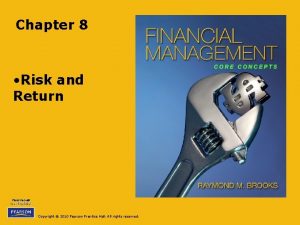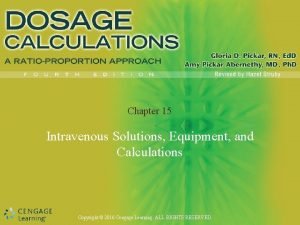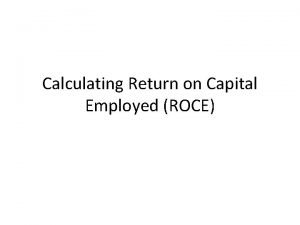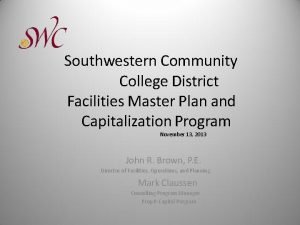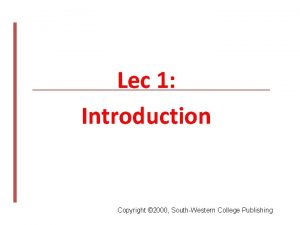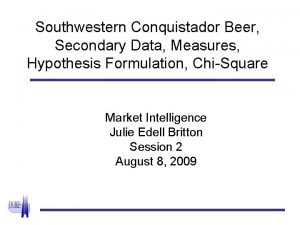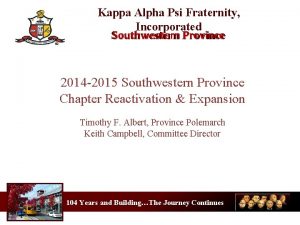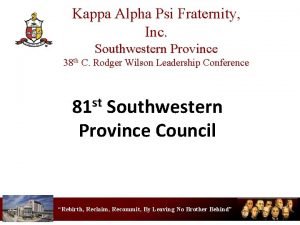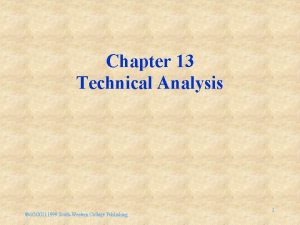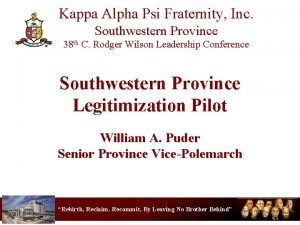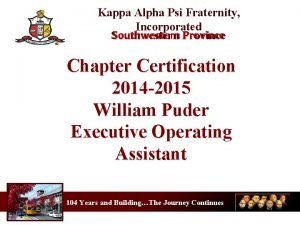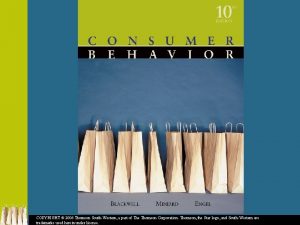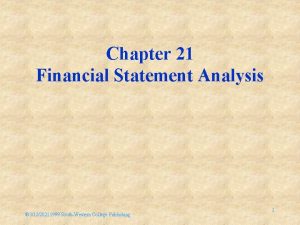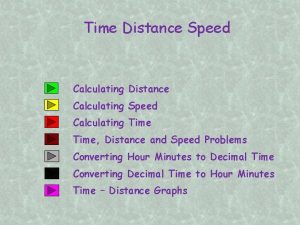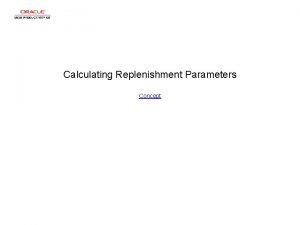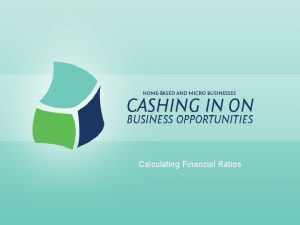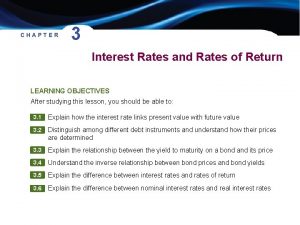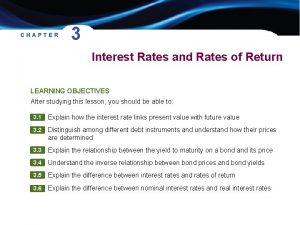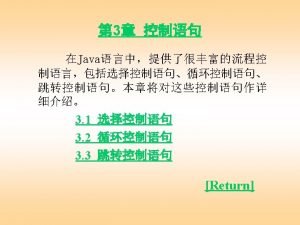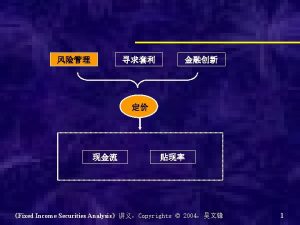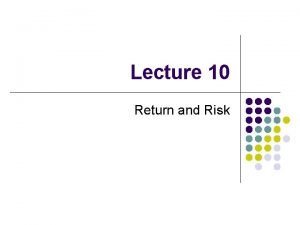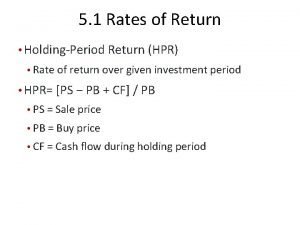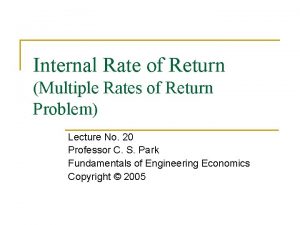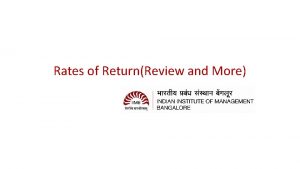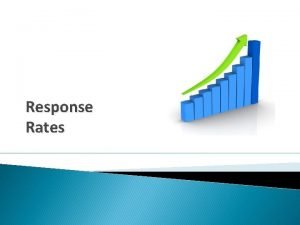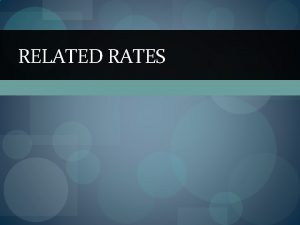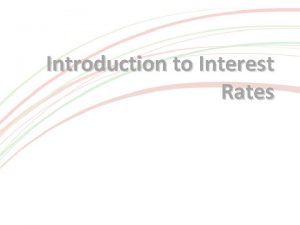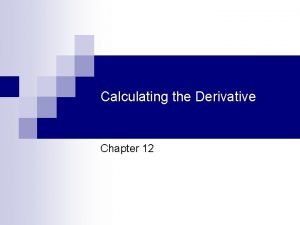Chapter 5 Calculating Rates Of Return 31220211999 SouthWestern


























- Slides: 26

Chapter 5 Calculating Rates Of Return ® 3/12/20211999 South-Western College Publishing 1

Using Rates Of Return • Uses – Comparing investments in different assets – Measuring historical performance – Determining future investment – Estimating the cost of capital • Percentage Figures Standard Practice • Dollar Amount Meaningless ® 3/12/20211999 South-Western College Publishing 2

Measuring Historical Performance • Ex-Post Rates of Return – Realized rates of return • Ex-Ante Rates of Return – Expected rates of return • Requires Knowledge of Risk – Risk-return relationship ® 3/12/20211999 South-Western College Publishing 3

Determining Future Investment • Estimate – Future return – Future fluctuations of returns • Historical Averages – Give best estimate of future returns – Estimate future fluctuations of returns • Next Year’s Returns – May be dramatically different ® 3/12/20211999 South-Western College Publishing 4

Estimating Cost Of Capital • Rates of Return – Used to estimate the firm’s cost of capital – NPV calculations • Utilizing historical rates of return – Calculated in more than one way ® 3/12/20211999 South-Western College Publishing 5

Rate-Of-Return Calculations • Different Methods – Yield different results • Could Use Method Giving Best Result – Lack of standard would affect comparability • AIMR – Association of Investment Management and Research – Established strict guidelines ® 3/12/20211999 South-Western College Publishing 6

Simple Rates Of Return • HPR – Holding period return EMV - BMV + I R= BMV – Limitations (does not account for) • Timing of cash dividends • Accrued interest ® 3/12/20211999 South-Western College Publishing 7

Capital gain or loss Rate of return components Cash flow yield ® 3/12/20211999 South-Western College Publishing 8

Approaches To Computing The Rate Of Return • Linking Method – Calculate to each subperiod – Cash dividends date determines subperiod – Simple to calculate • Index Method superior calculation – Cash flows used to purchase additional units – Useful to understanding time weighted computations ® 3/12/20211999 South-Western College Publishing 9

Bond Returns • Cash Basis – Ignores accrued interest • Accrual Basis – Bond interest accrues daily – Price paid for bonds • Includes accrued interest – AIMR accepted ® 3/12/20211999 South-Western College Publishing 10

After-Tax Rates Of Return • Includes the Impact of Taxes – Ordinary income – Capital gains Rn = EMVn - BMVn - N 0(Pn - P 0)Tg+ In(I - T) ® 3/12/20211999 South-Western College Publishing BMVn 11

Inflation-Adjusted Rates Of Return • Reduction of Purchasing Power • Inflation Measured By CPI – Consumer Price Index • Real Rate of Return CPI 1 - CPI 0 h= CPI 0 ® 3/12/20211999 South-Western College Publishing 12

Exchange Rates • Falling Dollar – Good for U. S. investors in foreign countries – Bad foreign investors in U. S. – U. S. industry more competitive – Foreign securities become more valuable – Foreigners shy away from U. S. markets ® 3/12/20211999 South-Western College Publishing 13

Rate Of Return Adjusted Foreign Exchange Risk RD = fxn (DC / FC) fx 0 (DC / FC) (1 + RL) - 1 Alternative Method RD = (1 + Rfx) (1 + RL) - 1 ® 3/12/20211999 South-Western College Publishing 14

Average Rate Of Return • • Measuring Returns Across Years Arithmetic Average – Adds the realized rate of return over different periods – Correct for one period of time – Unbiased estimate of future expected rates of return • Geometric Method – Compounds rates of return – Measures actual growth of assets ® 3/12/20211999 South-Western College Publishing 15

Adjusted Rate Of Return • Accounts for the Timing of Cash Dividends • Called Time-Weighted Rate of Return • Called Rate of Return in Rest of Textbook • AIMR Approved ® 3/12/20211999 South-Western College Publishing 16

Importance Of Indexes • Stock Indexes – Measure the general performance of an economy • Benchmark For Gauging Performance – Money manager – Bond fund manager • Serves as a Guide for Mutual Fund Performance • Assess Overall Direction of the Market • Estimates Statistical Parameters Beta • Used as Underlying Securities in Derivatives ® 3/12/20211999 South-Western College Publishing 17

Indexes Differ • By Which and How Many Securities • By How the Index is Adjusted for Change • By Method Used to Adjust Index ® 3/12/20211999 South-Western College Publishing 18

Types Of Indexes • Price-Weighted Index • Value-Weighted Index • Equally Weighted Index ® 3/12/20211999 South-Western College Publishing 19

Price-Weighted Index • Value – Found by adding the prices of each security and dividing by a divisor • Divisor – Adjusted for stock dividends and splits and other changes • Easy to Mimic ® 3/12/20211999 South-Western College Publishing 20

Value-Weighted Indexes • Value – Based on the total market value of a security • Market Capitalization – The greater the market capitalization the greater the securities influence • Not affected by stock dividends or splits ® 3/12/20211999 South-Western College Publishing 21

Equally Weighted Index • Value – Give each security the same weight • Arithmetic Method • Results in higher values than geometric • Multiplicative Method – Geometric ® 3/12/20211999 South-Western College Publishing 22

Stock Indexes • Most are Value-Weighted – Automatically adjusting for stock splits – Weight based on market capitalization • Easy to Develop and Maintain ® 3/12/20211999 South-Western College Publishing 23

Bond Indexes • • Track Different Segments of Bond Market Incorporate Total Returns (1970’s) Prior Indexes Ignored Coupon Payments Bonds Change Because – Of finite maturity change risk – Call features • Pricing Problems Due to Lack of Trading ® 3/12/20211999 South-Western College Publishing 24

Differences In Bond Indexes • Weighting Methods • Reinvest of Intramonth Cash Flows • Maturity Structure of Index ® 3/12/20211999 South-Western College Publishing 25

Tracking Rates Of Return Over Time • Common Stock is More Volatile than Bonds • Common Stock Offers Higher Return than Bonds • Positive Relationship Between Risk and Return ® 3/12/20211999 South-Western College Publishing 26
 Chapter 8 risk and rates of return problem solutions
Chapter 8 risk and rates of return problem solutions Calculating iv drip rates
Calculating iv drip rates Iv push rate
Iv push rate Capital employed formula
Capital employed formula Unit ratio
Unit ratio Proportions guided notes
Proportions guided notes Ratios rates and unit rates
Ratios rates and unit rates Ratios rates and unit rates
Ratios rates and unit rates Southwestern community college
Southwestern community college South-western college publishing
South-western college publishing Kappa alpha psi southwestern province
Kappa alpha psi southwestern province Southwestern college publishing
Southwestern college publishing Southwestern college cincinnati ohio
Southwestern college cincinnati ohio Southwestern conquistador beer
Southwestern conquistador beer Southwestern province kappa alpha psi
Southwestern province kappa alpha psi Kappa alpha psi moratorium
Kappa alpha psi moratorium Kappa alpha psi southwestern province
Kappa alpha psi southwestern province Century 21 southwestern accounting
Century 21 southwestern accounting Southwestern college publishing
Southwestern college publishing Kappa alpha psi southwestern province
Kappa alpha psi southwestern province Rutgers law symplicity
Rutgers law symplicity Sinai baltimore ophthalmology residency
Sinai baltimore ophthalmology residency Catherine carpenter southwestern
Catherine carpenter southwestern William puder kappa alpha psi
William puder kappa alpha psi Thomson southwestern
Thomson southwestern Chapter 18 review chemical equilibrium section 3 answer key
Chapter 18 review chemical equilibrium section 3 answer key Chapter 7 interest rates and bond valuation
Chapter 7 interest rates and bond valuation
